An intern’s experience in the archive
A Collections Chronicles Blog
by Sua L. Mendez, Collections Management and Archives Intern
June 24, 2021
Hello! This is Sua Mendez, Collections Management and Archives Intern at the Seaport Museum. I started my fully remote internship at the Museum in February 2021, and one of the first projects that I worked on involved the researching and cataloguing of 50 photographs in the Herman N. Schnittman Collection.
Overall, this was a very interesting project because it allowed me to delve into an extensive research project surrounding a single individual. Through this, I was able to learn about the Merchant Marines and life on board vessels during World War II. There was also a general lack of documentation, which made the research process challenging, but ultimately, more satisfying whenever new information was found or confirmed.
Collection Background
The Herman N. Schnittman Collection was first gifted to the South Street Seaport Museum in 1998 by Schnittman’s wife, Elaine Schnittman (née Eisner), and was later processed into the Museum’s collection on December 10, 1999. Originally, the donation included 74 photographs and a scrapbook consisting of various documents and correspondence relating to Schnittman’s maritime career. Ultimately, 24 of the photographs were returned to the donor due to a lack of collection relevancy, while 50 of the photographs and the scrapbook were retained by the Museum.
The donation itself was accepted by then Curator of Collection, Steven Jaffe, who recalls that the collection included various materials and photographs collected and taken by Schnittman while he was a seaman and sailed around the world during World War II.
Hermann Schnittman, of Staten Island, NY, was born on December 6, 1921 [1] Herman Schnittman (1921) Veterans Affairs BIRLS Death File, on Fold3 by Ancestry. (Available through Ancestry). According to Jaffee, Herman Schnittman may have also grown up in a Jewish orphanage in New York City prior to being trained as a seaman.
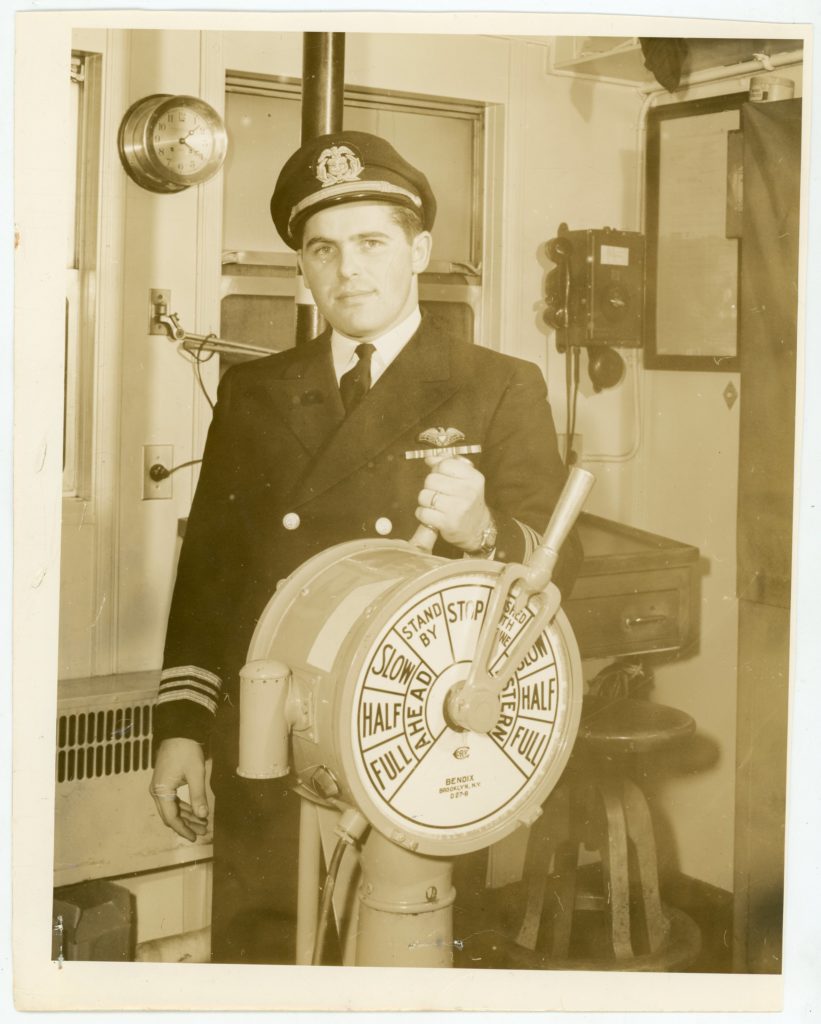
Correspondence described in the Museum’s Herman N. Schnittman Document Collection Finding Aid additionally suggests that Schnittman began working alongside the United States Maritime Commission (USMS) sometime between 1941 and 1942. The 1944 Register of Commissioned and Warrant Officers also confirms that in 1944, Schnittman was an Ensign Junior Officer (ENS) for the U.S. Navy [2] Register of Commissioned and Warrant Officers of the United States Naval Reserve, 1944, by the U.S. Government Printing Office, p. 1144.. If found, a U.S. Navy Officer Service Record described in the Document Collection Finding Aid may confirm this further.
After 1944, Schnittman was the Master of SS Hendrik Willem Van Loon. A photograph depicting Schnittman with one hand on a ship’s engine order telegraph specifically identifies him as the Chief Officer (or Lieutenant Commander) of a “C-2 operated by U.S. Lines.”
“Portrait of Lt. Comdr. Herman Schnittman” January 8, 1945. South Street Seaport Museum 1999.001.0002
The liberty ship SS Hendrik Willem Van Loon was an emergency cargo 2 (or C-2) ship, meaning that the ship pictured in this photograph is likely SS Hendrik Willem Van Loon [3] Ships built under the Merchant Marine Act of 1936, compiled by Frank A. Gerhardt.. Liberty ships like SS Hendrik Willem Van Loon were specifically mass-produced for the shipbuilding program that began under the passage of the Merchant Marine Act of 1936 [4] Liberty Ships and Victory Ships, America’s Lifeline in War (Teaching with Historic Places), published on NPS.gov.. 2,710 of these were liberty ships, which functioned as freighter cargo ships during World War II for the U.S. Merchant Marine.
Interestingly, the identifying note that describes this was previously attached to this photograph with metal staples (pictured above) but has since been removed by the Director of Collections, Martina Caruso, as of March 16, 2021. Original fasteners such as staples, paper clips, or rubber bands are typically removed when found on archival material because they are considered harmful to paper objects and may cause staining or discoloration. Staples in particular may oxidize, resulting in stains, and further cause tears in paper-based materials [5] Everyday Preservation Activities in Collections Storage, by Nancy Bateman and Laura Hicken, from the National Building Museum, October 1, 2019.
Outside of his career, Schnittman married Elaine Eisner of Staten Island, New York in 1943 [6] Elaine Schnittman Obituary, published by silive.com, March 14, 2011.. After being released from the Merchant Marine on March 5, 1945, Schnittman owned a commercial carpet business in Manhattan, New York. [7] LETTERS: Eternal Carpet, letter to the editor of the New York Times by Mimi Friend Schnitmman, January 2, 2002. (Available through ProQuest)
Schnittman and the Merchant Marine
As a Merchant Mariner, Schnittman likely helped to import and export goods to other countries during World War II. Merchant Mariners were notably placed on front lines and were typically shipped out in liberty ships after training in the U.S. Merchant Marine Academies [8] American Merchant Marine Men and Ships in World War II, on USMM.org, May 8, 2002..
Merchant Marine ships were typically commanded by a Captain or Master and the crew was equally made up of mates or deck officers, ordinary seamen, pilots, and engineers[9]. How to Join the Merchant Marine, on MITAGS (The Maritime Institute of Technology and Graduate Studies), August 27, 2020.. Many of the photographs included in this collection, such as the one pictured below depict seamen and ship crews onboard.
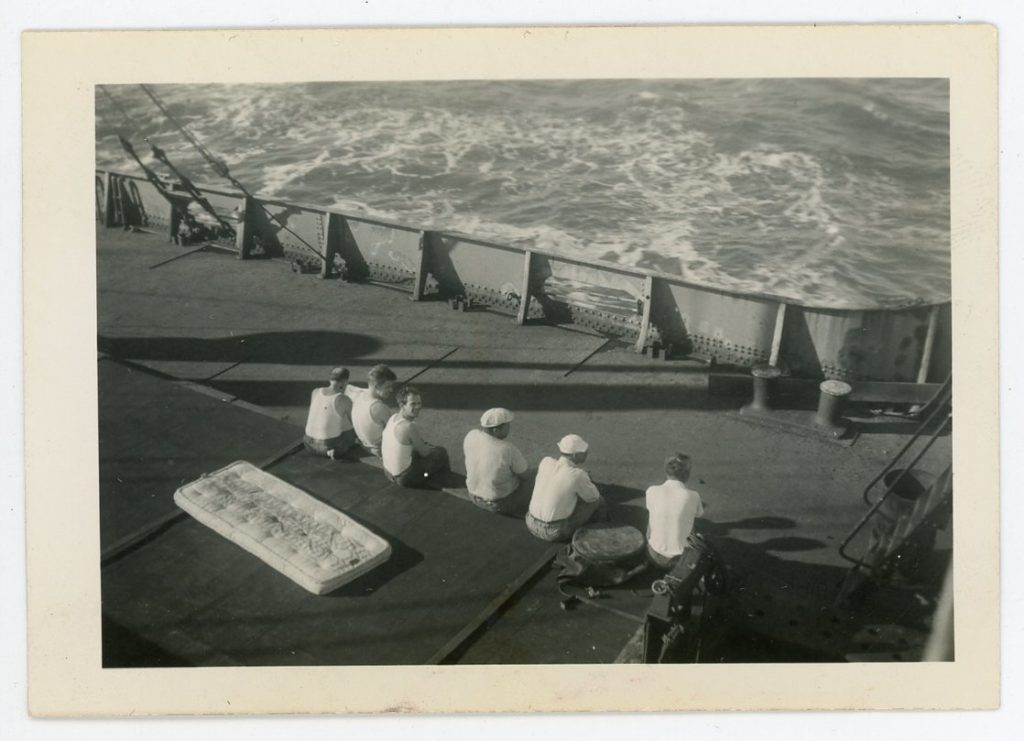
“Six seamen on deck of ship” ca. 1945. South Street Seaport Museum 1999.001.0018
However, many of the photographs in the collection are not dated, and have therefore been labeled “ca. 1945” instead. These photographs may depict either SS Hendrik Willem Van Loon or MS Santa Barbara, SS Bienville, American Manufacturer, SS Arizpa, John Stevens, SS Robin Adair, or SS Harold Winslow, based on a list of ships that Schnittman sailed on throughout his career from 1940-1945 which may be found in the Document Collection Finding Aid under the series: “Certificates of Discharge,” but this remains unconfirmed as of March 2021.
SS Bienville, in particular, is one of the ships depicted several times throughout the collection.
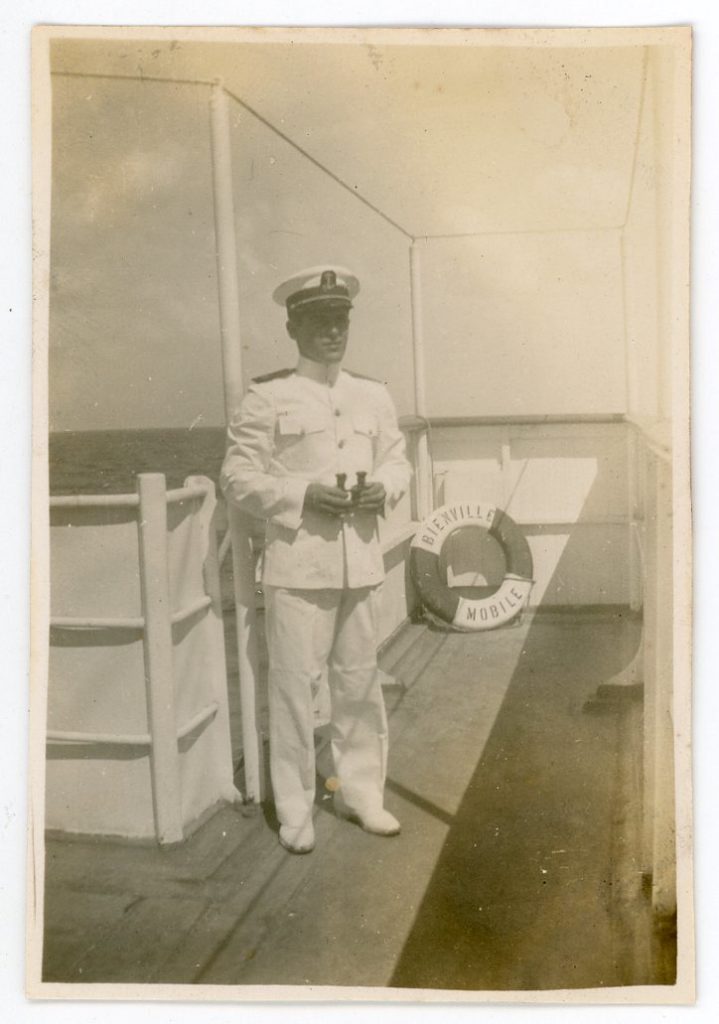
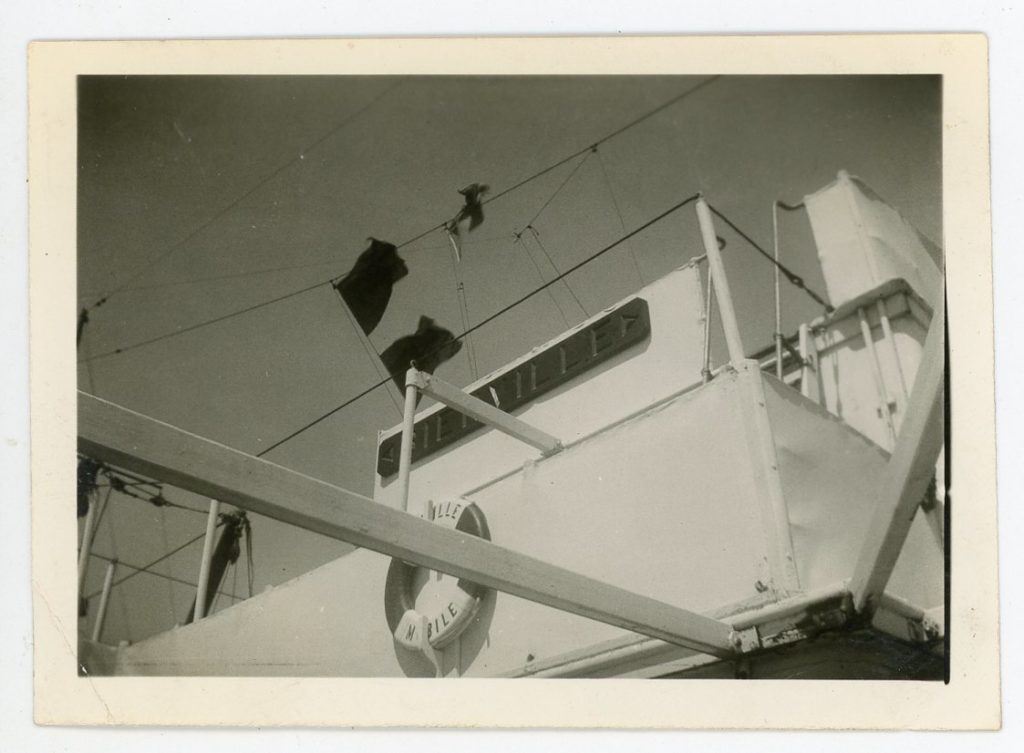
Right: “Herman Schnittman on SS Bienville” ca. 1940. South Street Seaport Museum 1999.001.0045
Left: “SS Bienville in Cristóbal” ca. July 1940. South Street Seaport Museum 1999.001.0027
According to Certificates of Discharge described in the Collection Finding Aid, Schnittman likely sailed on SS Bienville between July 1940 and December 1940.
Throughout his career, Schnittman further sailed around the world and photographed people and locations in Japan, Peru, Chile, and the Philippines. 1999.001.0050 (pictured below), for instance, depicts an earthquake that occurred in Callao, Peru in 1940.
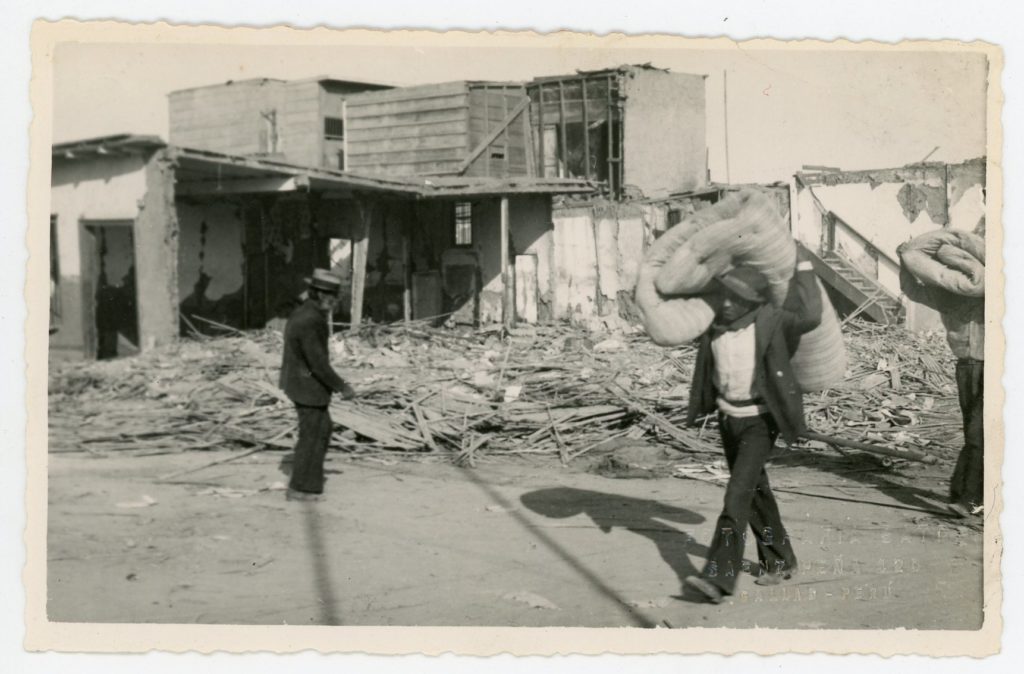
“Earthquake in Callao, Peru” June 1940. South Street Seaport Museum 1999.001.0050
SS Hendrik Willem Van Loon
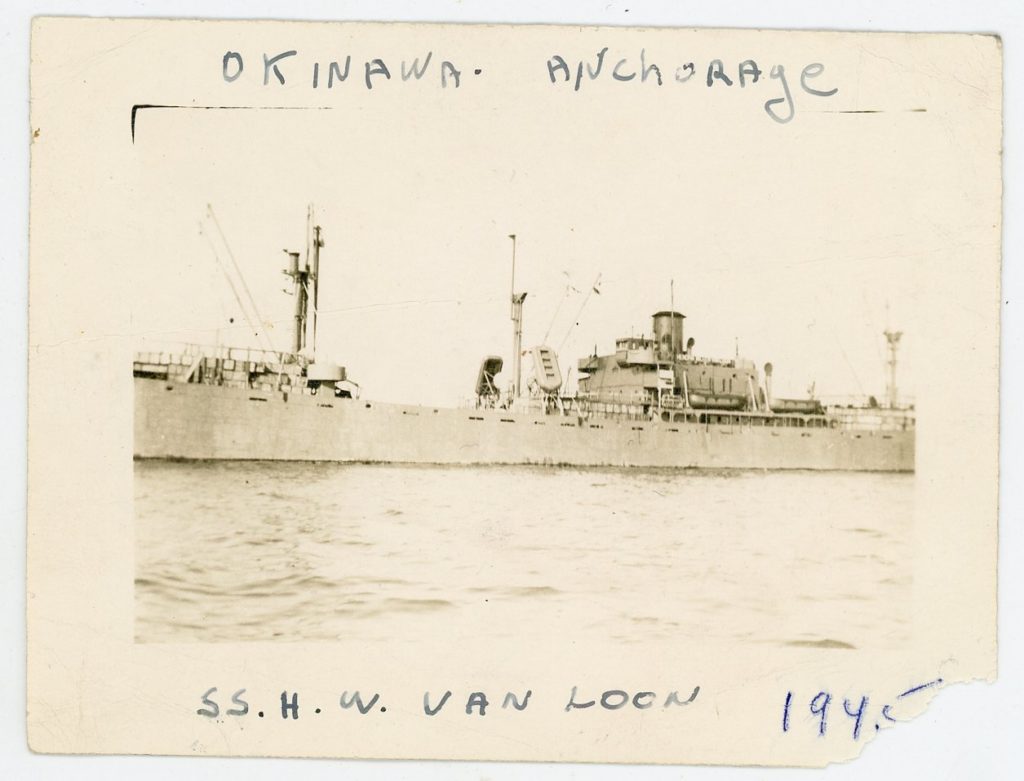
SS Hendrik Willem Van Loon (pictured left) was an emergency cargo liberty ship built in the United States by the St. Johns River Shipbuilding Co. during World War II.
The ship itself was named after the Dutch American historian, journalist, and children’s book author of the same name and was sponsored by his wife.
The ship was further laid down on May 5, 1944 and launched on June 14, 1944 before being completed on July 2, 1944 [10]St. Johns River Shipbuilding, Jacksonville FL, published on shipbuildinghistory.com.
“SS Hendrik Willem van Loon” 1945. South Street Seaport Museum 1999.001.0003
Prior to this, the ship was also allocated to United States Lines Co. on May 5, 1944 [11] HENDRIK WILLEM VAN LOON, on MARAD Maritime Administration, United States Department of Transportation.. Sometime after, the ship notably caught fire in slag ballast around December 13, 1945 before being temporarily allocated to the Japanese Government by the United States Department of War on February 11, 1946. In 1947, SS Hendrik Willem Van Loon was then laid up in the National Defense Reserve Fleet in Astoria, Oregon. The ship was later withdrawn from the fleet and loaded with grain for an, as of yet undetermined, “1954 Grain Program” and later unloaded in 1956. Ultimately, the ship was sold to and scrapped by Zidell Explorations Inc. in 1965.
Inventory Process
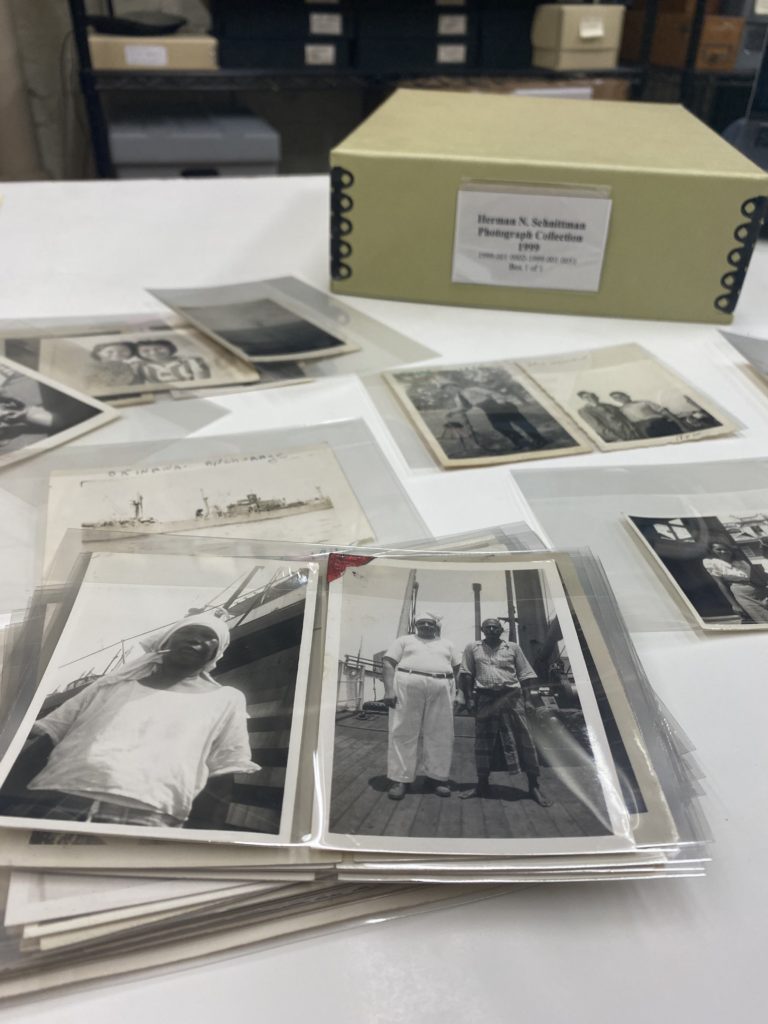
The Herman N. Schnittman Collection’s final deed of gift was signed on December 9, 1999. However, the acquisition record and most of the fields in the individual object records pertaining to this collection within the Museum’s database were left blank. It was, thus, my responsibility to research the collection and add any resulting information to the database.
To begin this project, which was done remotely, Director of Collections Martina Caruso scanned and uploaded each photograph onto our collection management database, Collector Systems, while working on-site. I then researched Herman Schnittman and the history of SS Hendrik Willem Van Loon to have a basic understanding of the subjects depicted in the photographs.
After this, I examined each photograph digitally, both recto and verso (front and back), for labels, dates, or any additional information or clue as to where and when these photographs were taken during World War II.
Next, I described the images visually and made note of handwritten inscriptions, or notes that appeared on the photographs verso, and added all of the information that I found in each database record’s Inscription and Research and Notes fields, if applicable. Lastly, once all previous information had been gathered, I examined the photographs once more and added applicable subject lines to the Subject field to make searching for any objects that depict similar themes or subjects easier to find within the database.
After my inventory, the Schnittman photographs have up-to-date database entries that make it more accessible to current and future researchers. Conducting routine inventories, in particular, is a crucial process associated with Collections Management because it allows museum staff to maintain an accurate record and count of objects that are held in the collection. While conducting an inventory, museum staff are further able to note any significant changes in the object’s condition and can also identify whether specific objects require new housing or care. By updating database entries, the Museum also ensures that information relating to a collection is accurate and well documented.
Conclusion
As a graduate student who recently graduated with an M.A. in Museum Professions with a professional concentration in Registration/Collections Management from Seton Hall University, I have interned and worked at various museums, archives, and cultural organizations where I was granted the opportunity to work closely with numerous types of museum collections. On many occasions, I was fortunate enough to have handled, researched, and catalogued significant photographic collections. At the South Street Seaport Museum, this personal and professional interest in photographs was nurtured within a remote environment, and I was grateful to have had the opportunity to research and learn about the life of Herman N. Schnittman while cataloguing the photographs in this collection.
During this project, I learned how to best describe photographic objects and transcribe inscriptions or notes that physically appear on these same objects. I also specifically learned how to best describe ships and vessels, as well as other items pertinent to maritime collections. At the same time, I was able to use and learn the Collector Systems database, which is a database that I had not worked with previously. Ultimately, I am confident that I have gained valuable experience on how to properly catalogue and research museum collections.
Additional readings and resources
The Merchant Marine Were the Unsung Heroes of World War II, by William Geroux, published in Smithsonian Magazine on May 27, 2016.
U.S. Merchant Marine in World War II, published on USMM.org.
Everything You Need to Know About the Merchant Marine, by Harold C. Hutchison, published on Military.com on March 16, 2020.
References
| ↑1 | Herman Schnittman (1921) Veterans Affairs BIRLS Death File, on Fold3 by Ancestry. (Available through Ancestry) |
|---|---|
| ↑2 | Register of Commissioned and Warrant Officers of the United States Naval Reserve, 1944, by the U.S. Government Printing Office, p. 1144. |
| ↑3 | Ships built under the Merchant Marine Act of 1936, compiled by Frank A. Gerhardt. |
| ↑4 | Liberty Ships and Victory Ships, America’s Lifeline in War (Teaching with Historic Places), published on NPS.gov. |
| ↑5 | Everyday Preservation Activities in Collections Storage, by Nancy Bateman and Laura Hicken, from the National Building Museum, October 1, 2019 |
| ↑6 | Elaine Schnittman Obituary, published by silive.com, March 14, 2011. |
| ↑7 | LETTERS: Eternal Carpet, letter to the editor of the New York Times by Mimi Friend Schnitmman, January 2, 2002. (Available through ProQuest) |
| ↑8 | American Merchant Marine Men and Ships in World War II, on USMM.org, May 8, 2002. |
| ↑9 | . How to Join the Merchant Marine, on MITAGS (The Maritime Institute of Technology and Graduate Studies), August 27, 2020. |
| ↑10 | St. Johns River Shipbuilding, Jacksonville FL, published on shipbuildinghistory.com |
| ↑11 | HENDRIK WILLEM VAN LOON, on MARAD Maritime Administration, United States Department of Transportation. |

